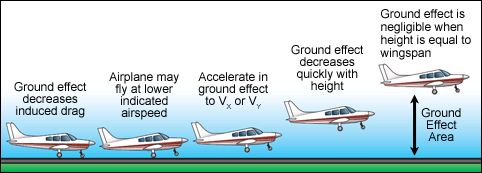| This ePilot Flight Training Edition is sponsored by

Advertisers
          
Do not reply to this e-mail. Got news? Contact ePilot. Having difficulty using this service? Visit the ePilot Frequently Asked Questions now at AOPA Online or write to [email protected].
Aircraft Owners and Pilots Association
421 Aviation Way
Frederick, MD 21701
Tel: 800/USA-AOPA or
301/695-2000
Copyright © 2007 AOPA. | Training Tips
| | UP AND AWAY
Liftoff is an ever-so-brief moment that culminates a workload-intensive takeoff run. It is a dynamic phase in which the pilot's ability to focus on multiple tasks preserves safety and eases a smooth departure. You'll be managing several tasks from the instant your aircraft begins to fly. One is making sure that you have achieved a positive liftoff-that your airspeed is high enough to ensure that your aircraft will climb away and accelerate to the desired climb speed-V x or V y-after exiting ground effect (see the January 31, 2003, Training Tips article "Ground effect: Playing the float").  Simultaneously you must be alert to and adjust for the effects of any crosswind by crabbing into the wind. Use only a slight bank angle, then keep the wings level on your adjusted heading once you are safely clear of the ground. Failing to make this important correction can result in your aircraft drifting downwind during the climb. "During the initial climb, it is important that the takeoff path remain aligned with the runway to avoid drifting into obstructions, or the path of another aircraft that may be taking off from a parallel runway," advises Chapter 5 of the Airplane Flying Handbook. See the chapter's list of the common errors encountered in the performance of takeoffs. Coordinated flight, as in all other phases, must be managed during the liftoff and initial climb, when high power and low airspeed amplify the left-turning tendencies of a single-engine trainer. Combat an uncoordinated condition through sufficiently aggressive application of right rudder. Resolve to lower the nose as your very first reaction to a loss of power immediately after takeoff. Then, depending on the length of your departure runway, the headwind component, and your altitude above the ground, activate your already-thought-out plan of emergency action. Richard Hiner explains how to consider the options for this task in his "Instructor Report" column in the December 1999 AOPA Flight Training . The transition from ground to air is a brief moment in a flight, but executing it smoothly helps you to climb safely to your cruise altitude, intercept your course promptly, be ready to handle departure communications, and enjoy the thrill of your flight.
| Your Partner in Training
| | Spring is just around the corner-we promise-and it's a beautiful time to fly. But early spring brings stronger, more prevalent winds, and every landing is different because the wind will change everything. Learn how to fly in this environment and become comfortable with handling the aircraft. Recommended reading, available for download, includes the AOPA Air Safety Foundation's Safety Advisor Ups and Downs of Takeoffs and Landings and the "Safety Pilot" article "Too windy?" If you still have questions, call AOPA's Pilot Information Center at 800/USA-AOPA weekdays from 8:30 a.m. to 6 p.m. Eastern. As an AOPA Flight Training member, you have access to all of the features within AOPA Online and AOPA Flight Training Online. Login information is available online.
| Flight Training News
| | NEW YORK TRIES TO GROUND STUDENT PILOTS, AGAIN
As if New York legislators haven't made it difficult enough for aviation enthusiasts to start flight training with the background check law that was enacted last year, they are at it again. The legislators are proposing to prohibit anyone under age 17 from operating an aircraft within the state. "We are strongly opposing this measure, as we have for the past five years it has been proposed," said Greg Pecoraro, AOPA vice president of regional affairs. "We'll fight this, just as we are to get the background check law repealed. Flight training cannot thrive in this kind of environment, and we are working to fix it." FAA regulations allow student pilots to solo at 16 years of age and earn a private pilot airplane certificate at 17. (They have to be 14 to solo balloons and gliders and 16 to receive certificates.) Under this proposed bill, student pilots couldn't fly solo in the state once they turned 16, and those in nearby states would have to be sure not to fly into New York on their solo cross-countries. AOPA told the Committee on Economic Development, Job Creation, Commerce, and Industry, which is reviewing the bill, that the FAA and Transportation Security Administration regulate flight schools, training, and security-not the state. ARKANSAS NAMES 2007 CFI OF THE YEAR
Don Gus Opitz, a 3,000-plus-hour pilot, was named Arkansas' Flight Instructor of the Year earlier this month. Opitz is a Gold Seal Flight Instructor with commercial, instrument, and multiengine ratings. He is a part-time instructor at Central Flying Service, based at Little Rock National Airport, and also provides pilot services for local corporations. Sponsors of the event were the Little Rock Flight Standards District Office, the Arkansas Department of Aeronautics, and the governor's office. YOUNG PILOT TO MAKE INSPIRATIONAL GLOBAL JAUNT
AOPA President Phil Boyer swapped flying stories last week with 23-year-old Barrington Irving, an intrepid young pilot who plans a round-the-world flight in a Columbia 400 in March to promote aviation as a career to other young people. Irving visited AOPA headquarters in Frederick, Maryland, and discussed his flight plan with Boyer. Irving will leave Miami on March 23, and his route will take him to Ohio and New York before he begins the eastern route across the world. Stops are planned in Madrid, Rome, and Athens, and then on to areas such as Hong Kong, Taiwan, and Alaska. The five-week journey will end in Jamaica, where Irving was born. To read more about Irving's trip, see AOPA Online. WAI GREETS ASPIRING PILOTS
Orlando, Florida, was the place to be last week for aspiring pilots and aviation enthusiasts as Women in Aviation, International celebrated another record-setting conference February 15 through 17. The conference had 3,200 participants and 49 scholarship recipients by the end of its banquet ceremony on February 17. The final scholarship tally was just more than $385,000. AOPA's Project Pilot helped to kick things off with a "Learn to Fly" seminar, which drew pilots-to-be from both the conference and around the area. The goal was to match these future pilots with prospective AOPA Project Pilot Mentors. The conference was also a hit with aviation businesses looking for top-notch talent. Companies like Cessna, Garmin, Gulfstream, and Jeppesen were on the lookout for engineers, managers, test pilots, and marketing professionals, while FedEx, UPS, and Wal-Mart were among the corporate aviation exhibitors recruiting pilots and other aviation professionals.
| Inside AOPA
| | TURBOMEDICAL ACCEPTED BY FAA FOR MEDICAL CERTIFICATION
Trips to the doctor's office for aviation medical certificates just got a lot easier. The federal air surgeon has determined that aviation medical examiners (AMEs) may now accept printouts from AOPA's TurboMedical, as long as the printouts are signed in the presence of the AME or AME's staff. Until now, AOPA members who used TurboMedical had to transcribe the information from their printouts to FAA Form 8500-8. "This is a tremendous benefit and advantage for our members," said AOPA Director of Medical Certification Gary Crump. "The enhancements should really speed up a pilot's visit to his AME and reduce the number of errors caused by faulty transcription." FAA aeromedical officials were satisfied with some changes AOPA made to the TurboMedical layout, which eliminated confusion in the FAA's Aerospace Medical Certification Division. The one catch is that it needs to be attached to a blank Form 8500-8 for tracking purposes. See AOPA Online. AIRCRAFT ICING: DON'T LET IT SURPRISE YOU
Aircraft icing is one of aviation's most unforgiving hazards. With weeks of cold weather still remaining in many parts of the country, it's critical to understand aircraft icing. You'll learn what to do if you find yourself in icing conditions, and better yet, how to avoid icing altogether. Take the AOPA Air Safety Foundation Safety Quiz and enter your name for a chance to win a Sporty's Air-Scan V aviation radio/scanner. HAVE YOU UPDATED YOUR AOPA MEMBER PROFILE?
To make the most of your membership and allow us to serve you better, please visit AOPA Online and update your personal member profile.
| Training Products
| | GARMIN 396 ADAPTOR FROM SPORTY'S
If you own a Garmin 396 GPS receiver, chances are you never leave the ground without it. Now you can ensure that your view of the unit is unobstructed in the cockpit, thanks to a new accessory from Sporty's. The Garmin Horizontal Tilt Adaptor angles the GPS at a fixed angle of 15 degrees to provide you with a convenient viewing angle. It can be mounted in either direction, for pilots who fly from the right seat. The adaptor sells for $24.95 and can be ordered online. Note: Products listed have not been evaluated by ePilot editors unless otherwise noted. AOPA assumes no responsibility for products or services listed or for claims or actions by manufacturers or vendors.
| | Final Exam | | Question: What is the practical purpose of learning and practicing ground reference maneuvers? Answer: Ground reference maneuvers are designed to teach you how to control the aircraft smoothly and safely, while adjusting your flight path to offset the effect wind is having on your ground track. This is important for staying on a straight course while tracking en route to your destination, as well as for flying a nicely squared traffic pattern. With practice it will become second nature to divide your attention between the mechanics of making the turn and the subtleties of adjusting the turn rate as needed to compensate for wind drift. Read more on this topic in the article, "Ground reference maneuvers: Understanding the wind's effect on aircraft ground track." Got a question for our technical services staff? E-mail to [email protected] or call the Pilot Information Center, 800/872-2672. Don't forget the online archive of "Final Exam" questions and answers, searchable by keyword or topic.
| Picture Perfect
| Looking for some really fabulous aviation photography? All the air-to-air photos and beautifully detailed ground images used by AOPA Pilot magazine over the years are yours at the click of a mouse button. Download your favorite images to use for wallpaper, send an e-postcard, or order prints online. For more details, see AOPA Online.
| Weekend Weather
| See the current weather on AOPA Online, provided by Meteorlogix.
| ePilot Calendar
| UPCOMING FLYING DESTINATIONS:
Puyallup, WA. The 2007 Northwest Aviation Conference and Trade Show takes place February 24 and 25 at the Western Washington Fairgrounds. This event features hours of safety seminars, a huge exhibit hall, and nationally recognized speakers, including AOPA President Phil Boyer. Contact 866/922-7469, or visit the Web site. To submit an event to the calendar or to search all events visit AOPA Online. For airport details, see AOPA's Airport Directory Online. FLIGHT INSTRUCTOR REFRESHER CLINICS
The next AOPA Air Safety Foundation Flight Instructor Refresher Clinic is scheduled in Baltimore, March 3 and 4. Clinics are also scheduled in Ontario, CA, and Virginia Beach, VA, March 10 and 11. For a complete schedule, see AOPA Online. Can't make it in person? Sign up for the CFI Refresher Online. AOPA AIR SAFETY FOUNDATION SAFETY SEMINARS
AOPA Air Safety Foundation Safety Seminars are scheduled in Ann Arbor, MI, and Las Vegas, February 26; Cleveland, February 27; Whitehall, OH, February 28; and Indianapolis, March 1. The topic is "Say It Right! Radio communications for today's airspace." For details and a complete schedule, see AOPA Online.
| |